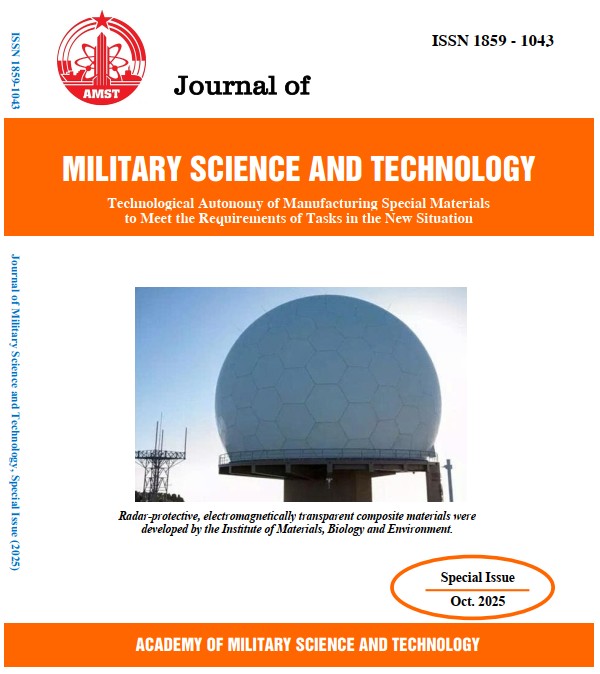Thermochemical activation of bagasse-derived carbon with HCl for methylene blue dye removal
DOI:
https://doi.org/10.54939/1859-1043.j.mst.IMBE.2025.108-114Keywords:
Activated carbon; Sugarcane bagasse; Thermochemical activation; Methylene blue; Adsorption; Wastewater treatment.Abstract
This study shows how to make activated carbon (AC) from sugarcane bagasse by treating it with hydrochloric acid (HCl) and using it to remove methylene blue (MB) dye from water. The bagasse was soaked in 7% HCl and carbonized at 450 °C to produce a porous carbonaceous adsorbent. The tests showed that the material had a structure with small pores, a large surface area of 473.8 m²/g, many oxygen groups, and a lot of non-crystalline carbon. Tests were conducted in batches to determine the impact of contact time on the removal efficiency of the dye. The AC demonstrated rapid adsorption, achieving 95.6% MB removal within 20 minutes. Kinetic data fitted better to the pseudo-second-order model, suggesting chemisorption as the dominant mechanism. Isotherm analysis supported favorable adsorption behavior. The results show that carbon made from HCl-activated bagasse is a good, eco-friendly, and inexpensive option for getting rid of cationic dyes in wastewater. Its promising performance highlights its potential in industrial dye remediation processes.
References
[1]. Dutta, S., et al. “Contamination of textile dyes in aquatic environment: Adverse impacts on aquatic ecosystem and human health, and its management using bioremediation.” Journal of Environmental Management, 353, 120103 (2024).
[2]. Vutskits, L., et al. “Adverse effects of methylene blue on the central nervous system.” Anesthesiology, 108(4), 684–692 (2008).
[3]. Singh, B. J., Chakraborty, A., and Sehgal, R. “A systematic review of industrial wastewater management: Evaluating challenges and enablers.” Journal of Environmental Management, 348, 119230 (2023).
[4]. Zinicovscaia, I. “Conventional methods of wastewater treatment.” In: Cyanobacteria for Bioremediation of Wastewaters, pp. 17–25 (2016).
[5]. Satyam, S., and Patra, S. “Innovations and challenges in adsorption-based wastewater remediation: A comprehensive review.” Heliyon, 10(9) (2024).
[6]. Oladoye, P. O., et al. “Advancements in adsorption and photodegradation technologies for Rhodamine B dye wastewater treatment: Fundamentals, applications, and future directions.” Green Chemical Engineering, 5(4), 440–460 (2024).
[7]. Mishra, R. K., Singh, B., and Acharya, B. “A comprehensive review on activated carbon from pyrolysis of lignocellulosic biomass: An application for energy and the environment.” Carbon Resources Conversion, 7(4), 100228 (2024).
[8]. Ahmadi, N., et al. “The adsorption capacity of activated carbon made from walnut shells: Composition, properties and environmental applications.” (2025).
[9]. Zhang, T., et al. “Preparation of activated carbon from forest and agricultural residues through CO₂ activation.” Chemical Engineering Journal, 105(1–2), 53–59 (2004).
[10]. Rashidi, N. A., et al. “Activated carbon from the renewable agricultural residues using single-step physical activation: A preliminary analysis.” APCBEE Procedia, 3, 84–92 (2012).
[11]. Tigrine, Z., et al. “Sustainable activated carbon from agricultural waste: A study on adsorption efficiency for humic acid and methyl orange dyes.” Sustainability, 16(21), 9308 (2024).
[12]. Amaresh, et al. “Sugarcane bagasse: Transforming waste into renewable and bio-compostable materials for a sustainable future.” In: Value Addition and Product Diversification in Sugarcane, Springer, pp. 239–256 (2024).
[13]. Melati, R. B., et al. “Sugarcane bagasse: Production, composition, properties, and feedstock potential.” (2017).
[14]. Gonçalves, S. P. C., et al. “Activated carbon from pyrolyzed sugarcane bagasse: Silver nanoparticle modification and ecotoxicity assessment.” Journal of Cleaner Production, 565, 833–840 (2016).
[15]. Lai, H. T., et al. “Sustainable removal of phenol from aqueous media by activated carbon valorized from polyethylene terephthalate (PET) plastic waste.” Molecules, 17(2), 548 (2025).
[16]. Demiral, İ., et al. “Enrichment of the surface functional groups of activated carbon by modification method.” Carbon Trends, 22, 100873 (2021).
[17]. Kalaba, G., et al. “Characterisation of activated carbons for removal of organic and heavy metal pollutants from water in resource-limited countries.” Journal of Environmental Chemical Engineering, 261, 224–233 (2022).
[18]. Congsomjit, D., Areeprasert, C. J., and Biorefinery. “Hydrochar-derived activated carbon from sugar cane bagasse employing hydrothermal carbonization and steam activation for syrup decolorization.” Biochar, 11(6), 2569–2584 (2021).







